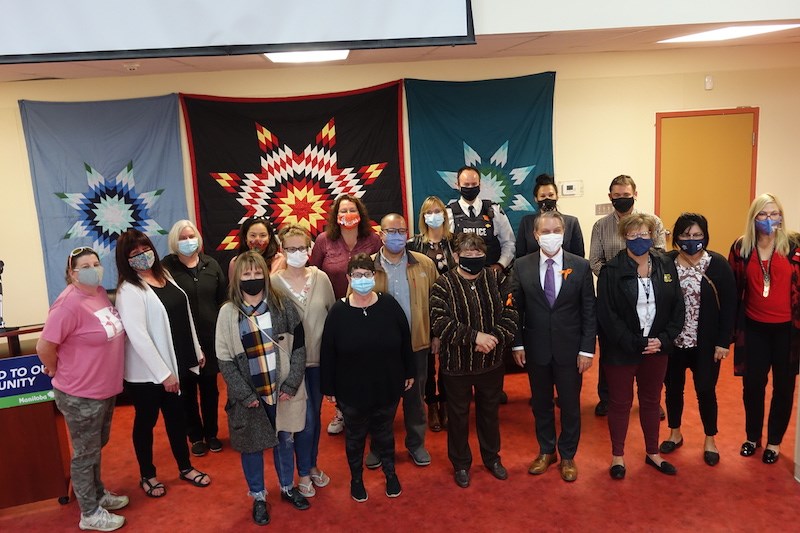The collaborative Thompson Community Safety and Well-Being Plan (CSWB) was officially released to the public Oct. 5 and includes concrete actions in six categories to be completed within the next five years.
Guided by an advisory committee representing more than 20 organizations in the city, including law enforcement, social services and health care, the plan was created with help from Community Safety Knowledge Alliance consultants and took about 18 months to come to fruition. The cost of the consultants was funded by the provincial government. A survey completed by about 2,300 Thompson residents and other community consultations also contributed to the content of the plan.
“You don’t know how long I’ve waited for this day,” said Mayor Colleen Smook.
The plan is broken down into six areas – integrated alcohol management demand on police resources, housing and homelessness, youth-involved crime and harm, built environment and social infrastructure, and community inclusion, system in equities and racism.
The goal is to have partners work in concert toward improving life in the city, instead of in silos without knowledge of similar programs and possibly duplicating efforts, as well as to identify gaps and foster a stronger sense of shared community among city residents.
“Thompson didn’t become this way overnight and it’s not going to change overnight,” advisory committee co-chair Dee Chaboyer, executive director of the Ma-Mow-We-Tak Friendship Centre, said during the official launch of the plan. “It’ll take careful co-ordination, a tremendous amount of commitment, and time. It will be no small feat but with committed leadership, a well-informed plan now to guide us and the support of mayor and council we will make a difference.”
Actions and timeframes identified in each of the six categories include the following:
- Integrated alcohol management: finalize the design of the sobering centre and launch its development (immediate to one year)
- Demand on police resources: implement institutional safety officer program (immediate); enhance the community safety officer program (one to two years); link community outreach workers to sobering centre and/or local Indigenous and mental health agencies (one to two years); establish police and crisis teams or mobile crisis teams (two years).
-Community inclusion, systemic inequities and racism: identify and act on opportunities to promote cultural proficiency and the history of the Indigenous experience, as well as to promote an inclusive community and address racism and systemic inequities in Thompson (immediate to one year).
- Housing and homelessness: revitalize Thompson Housing Agency (immediate to one year); update local housing needs assessment (immediate to one year); in partnership with landlords, develop proposed rent subsidy program to match Canada Mortgage and Housing Corporation’s recommended 30 per cent of pre-tax income for affordable housing (two to three years).
-Youth-involved crime and harm: provide information for youth on the social media platforms they use (immediate); promote welcoming and non-judgmental environments for at-risk youth (immediate to six months); deliver programs anchored to Indigenous knowledge and practices and trauma-sensitive practice (one to thee years);
- Built environment and social infrastructure: improve and repair lighting downtown and on Millennium Trail (immediate); increase frequency of garbage pickup downtown during warmer months (immediate); install public washrooms in downtown area (one year); complete planning and execute on design for new indoor pool (one to two years); repair and install sidewalks where needed (two to five years)
Among the measurable outcomes the plan hopes to achieve are a reduction in the number of alcohol-related calls that the RCMP receives, a decrease in the number of people who lack shelter, lower youth crime statistics and increased school attendance.
The plan anticipates that a project co-ordinator will need to be hired to help implement its many facets and that additional positions may eventually be needed to support that co-ordinator, either direct hires or in-kind contributions by partner organizations.
City manager Anthony McInnis said the idea is for the plan to evolve in accordance with the local situation.
“The plan is devised so that it grows over time as the advisory committee changes and the conditions change in the community. it’s continuously updated.”
Next steps include putting together implementation strategies for activities in each of the six areas and holding public events for city residents.
“People will have the community plan available for the community and be able to answer any of their other questions as well,”said Chaboyer.
Smook said she and her fellow councillors would be working behind the scenes to ensure partners in the plan are able to accomplish their goals.
“We’ll be working with all of you to make sure everybody gets the funding and help they need to make this go forward.”
To view the plan, go to the Community Wellness and Safety Advisory Committee website at cwsac.ca.





